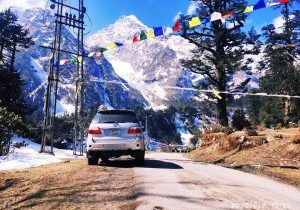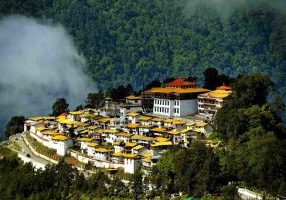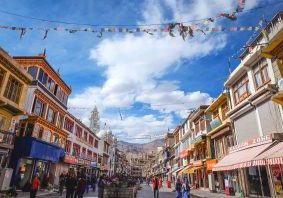Among a surreal landscape of golden-brown boulders and leafy banana fields, the ruined “City of Victory,” Vijayanagar, better known as Hampi (the name of the main local village), spills from the south bank of the River Tungabhadra. This once dazzling Hindu capital was devastated by a six-month Muslim siege in the second half of the sixteenth century. Only stone, brick and stucco structures survived the ensuing sack – monolithic deities, crumbling houses and abandoned temples dominated by towering gopuras – as well as the irrigation system that channelled water to huge tanks and temples, some of which are still in use today.
PLACES TO VISIT IN THIS REGION
Thus, Hampi’s monuments appear a lot older than their four or five hundred years. With its wooden superstructure burnt and past buried in ruins, excavations by the Archaeological Survey of India (ASI) can only piece together the fragmented history of this sophisticated city. Grappling with years of encroachment and the constant tussle between preservation and modernization, the Hampi World Heritage Area Management Authority (HWHAMA) has controversially pressed ahead with plans to revamp Hampi Bazaar and the adjoining “heritage zone”. Yet, at least for the time being, the serene riverside setting and air of magic that still lingers over the site, sacred for centuries before a city was founded here, make it one of India’s most extraordinary locations. Many find it difficult to leave and spend weeks chilling out in cafés, wandering to whitewashed hilltop temples and gazing at the spectacular sunsets.
Although spread over 26 square kilometres, the ruins of Vijayanagar are mostly concentrated in two distinct groups: the designated Sacred Centre around Hampi Bazaar and the nearby riverside area, encompassing an enclave of temples and ghats; and the Royal Enclosure – 3km south of the river, just northwest of Kamalapura village – which holds the remains of palaces, pavilions, elephant stables, guardhouses and temples. Between the two stretches is a long boulder-choked hill and scores of banana plantations, fed by ancient irrigation canals.
Getting to Hampi
Buses from Hosapete terminate close to where the road joins the main street in Hampi Bazaar, halfway along its dusty length.
Accommodation in Hampi
Hampi Bazaar remains the best place to stay for access to the sites, choice of restaurants and other facilities. There are no fancy hotels but a number of guesthouses of varying size and calibre. Some travellers, especially Israelis, prefer to stay across the river in Virupapuragadda, which is now well developed and has caught up in price. Still, prices are pretty low most of the year apart from the Christmas to mid-January peak, when they at least double.
Eating in Hampi
Hampi has a plethora of traveller-oriented restaurants, either in the bazaar, although guesthouse rooftop restaurants above the first floor have been banned, or among the growing row of joints in Virupapuragadda. As a holy site, the main village is strictly alcohol-free and almost entirely vegetarian. There are no such restrictions on the other side of the river.
Hampi Bazaar
Hampi’s long, straight main street, Hampi Bazaar, runs east from the entrance to the Virupaksha temple, and is lined by the remains of Vijayanagar’s ruined, columned bazaar. While the Bazaar has been cleared of all shops under a restoration initiative, the area north of the temple towards the river still houses a maze of restaurants, hotels and other businesses.
Matanga Hill
The place to head for sunrise is the boulder hill immediately east of Hampi Bazaar. From the end of the main street, an ancient paved pathway winds up a rise, topped by the magnificent Achyutharaya temple on the eastern ridge of Matanga Hill. The views improve as you progress up towards the small Veerabhadra temple at its summit, which provides an extraordinary vantage point. Muggings have been reported along this path early in the morning, so be vigilant if there are only one or two of you.
The riverside path
Walking east from the Virupaksha temple along the length of Hampi Bazaar, turn left before the huge monolithic Nandi statue to get to Vitthala temple. This riverside path, peppered by conch-blowing sadhus and ragged mendicants, winds past cafés and numerous shrines, including a Rama temple – home to hordes of fearless monkeys. Beyond at least four Vishnu shrines, a paved and colonnaded bazaar leads due south to the Achyutharaya temple (aka Tiruvengalanatha), whose beautiful stone carvings – among them some of Hampi’s famed erotica – are being restored by the ASI. Back on the main path again, make a short detour across the rocks leading to the river to see the little-visited waterside Agni temple; next to it, the Kotilinga complex consists of 1008 tiny lingas, carved on a flat rock. As you approach the Vitthala temple, to the south is an archway known as the King’s Balance, where the rajas were weighed against gold, silver and jewels to be distributed to Brahmins and the needy on festive occasions.
Vitthala temple
Although the area of the Vitthala temple does not show the same evidence of early cult worship as Virupaksha, the ruined bridge to the west probably dates from before Vijayanagar times. The bathing ghat may be from the Chalukya or Ganga period, but as the temple has fallen into disuse it seems that the river crossing (tirtha) here lacks the sacred significance of the Virupaksha site. Now part of the UNESCO World Heritage Site, the Vitthala temple was built for Vishnu, who according to legend was too embarrassed by its ostentation to live here.
The Saptasvara Mandapa (Open Dancing Hall) features slender monolithic granite musical pillars which were constructed so as to sound the notes of the scale when struck. Today, due to vandalism and erosion from being repeatedly beaten, heavy security makes sure that no one is allowed to touch them. Guides, however, will happily demonstrate the musical resonance of other pillars on an adjacent structure. Outer columns sport characteristic Vijayanagar rearing horses, while friezes of lions, elephants and horses on the moulded basement display sculptural trickery – you can transform one beast into another simply by masking one portion of the image.
In front of the temple, to the east, a stone representation of a wooden processional rath, or chariot, houses an image of Garuda, Vishnu’s bird vehicle. Now cemented, at one time the chariot’s wheels revolved.
Anegundi
With more time, and a sense of adventure, you can head across the River Tungabhadra to Anegundi (also spelt Anegondi), a fortress town predating Vijayanagar, and its fourteenth-century headquarters. The most pleasant way to get here is to take a coracle from the ford 1.5km east of the Vitthala temple; these circular baskets, which are today reinforced with plastic sheets, also carry bicycles, which are a good way to visit Hampi’s many monuments. A contentious bridge was constructed at this point but collapsed some years ago. A new one is being built outside the core heritage zone, at Bukkasagar, further downstream.
Forgotten temples and fortifications litter Anegundi village and its quiet surroundings. The ruined Huchchappa-matha temple, near the river gateway, is worth a look for its lathe-turned black stone pillars and fine panels of dancers. Aramane, a ruined palace in the centre, stands opposite the home of the descendants of the royal family; also in the centre, the Ranganatha temple is still active. A huge wooden temple chariot stands in the village square. Limited accommodation is available here in village houses and you can get basic snacks at the local stalls.
Hemakuta Hill
Directly above Hampi Bazaar, Hemakuta Hill is dotted with pre-Vijayanagar temples that date from the ninth to eleventh centuries. Aside from the architecture, the main reason to clamber up is to admire the views of the ruins and surrounding countryside. With views across the boulder-covered terrain and banana plantations, the sheer western edge of the hill is Hampi’s top sunset spot, attracting crowds of tourists most evenings, along with entrepreneurial chaiwalas and little boys posing for photos in Hanuman costumes.
A couple of interesting monuments lie on the road leading south towards the southern group of ruins. The first of these, a walled Krishna temple complex to the west of the road, dates from 1513. Although dilapidated in parts, it features some fine carving and shrines.
Hampi’s most-photographed monument stands just south of the Krishna temple in its own enclosure. Depicting Vishnu in his incarnation as the Man-Lion, the monolithic Ugra Narasimha statue, with its bulging eyes and crossed legs strapped into yogic pose, is one of Vijayanagar’s greatest treasures.
The southern and royal monuments
The most impressive remains of Vijayanagar, the city’s royal monuments, lie some 3km south of Hampi Bazaar, spread over a large expanse of open ground. Before tackling the ruins proper, it’s a good idea to get your bearings with a visit to the small Archeological Museum at Kamalapura, which can be reached by bus from Hosapete or Hampi. Among the sculptures, weapons, palm-leaf manuscripts and paintings from Vijayanagar and Anegundi, the highlight is a superb scale model of the city, giving an excellent bird’s-eye view of the entire site.




